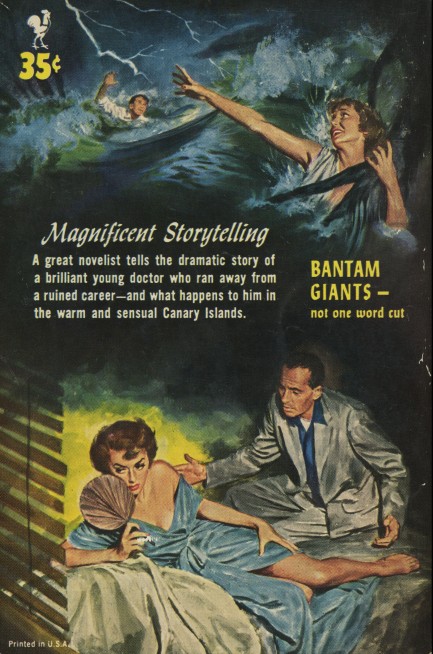 If you jump without looking you might get swept away. 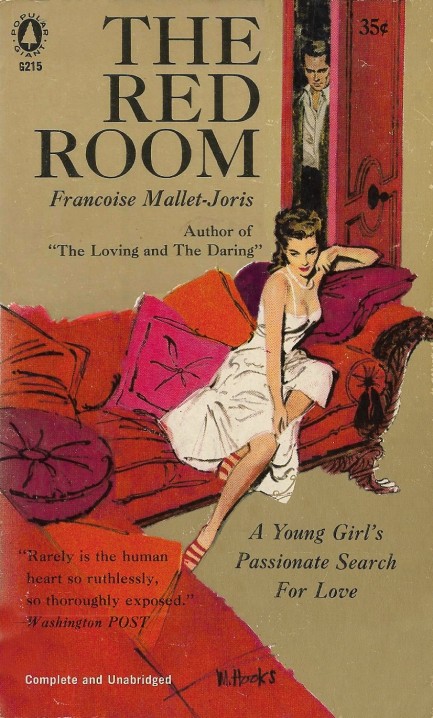
The book you see above, a 1958 Popular Library edition of The Red Room by Belgian author Françoise Mallet-Joris, was picked up for us by a friend who thought he was buying a pulp novel. He was attracted by the cover, and it's indeed fine work, from the skilled brush (and possibly ink quill and charcoal pencil) of Mitchell Hooks. As for the novel, it was originally published in 1955 as La chambre rouge and was a sequel to 1951's Le rempart des Béguines.
When someone buys us a book we always read it out of appreciation and respect, even romance novels, and in reading The Red Room we were reminded once again of the skill gap between literary and crime fiction. There are obviously excellent, transcendent crime writers (and literary fiction that misses the mark), but Mallet-Joris—even translated—spins evocative phrases as deftly as a weaver with a loom. Like this one:
The presence of winter—vulgar winter, befurred and jangling her crystal adornments—was scarcely felt in the small white and gold drawing room.
Isn't that nice? It's not Hammett describing a gangster popping off shots in a crowded bar, but it's still fun to read. The tale is a coming of age breast-beater set in Gers, France in which the main character, eighteen-year-old Hélène Noris decides to steal the dashing young film director her hated stepmother Tamara has earmarked for extra-marital games. That actually sounds kind of pulp, doesn't it? Well, just wait.
At some point it becomes clear that Hélène had been Tamara's young lover (probably this is the central plot of the previous book). Tamara and Hélène had been carrying on, but in order to secure for herself a stable existence Tamara decided to marry Hélène's father. Thus, The Red Room charts Hélène as she impulsively steals her stepmother's crush, only to find herself getting in too deep with someone who's more experienced and decisive than any man she's known.
Needless to say, that plot sounds like some of the sleaze novels we highlight here, which would make you wonder, in terms of public perception, at which point the lowbrow becomes highbrow. And the easy answer to that is: when you can write like Mallet-Joris and critics adore you. Overall, The Red Room is probably a little too genteel and interiorized for most pulp readers, but we liked it. Consider that less a recommendation than an acknowledgment of talent.
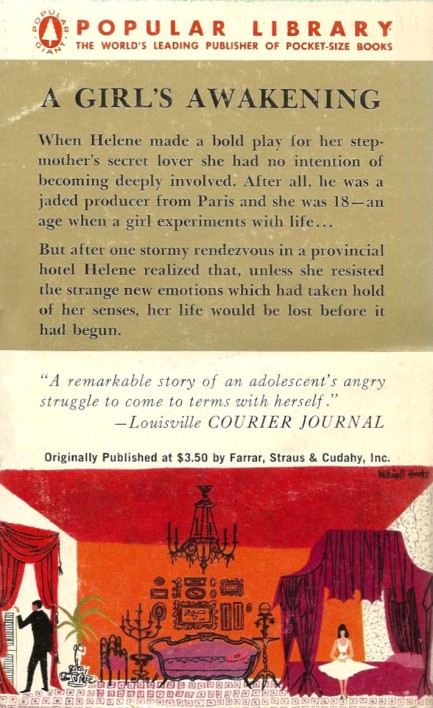 
 I believe you that it's life or death, honey. But believe me it's also life or death that I finish my toes. 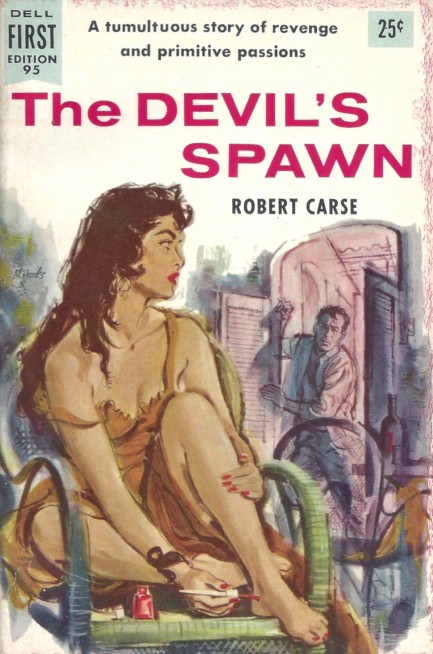
The Devil's Spawn was a random acquisition, a cheap throw-in within a six-book lot. It's a 1956 Dell original with cover art by Mitchell Hooks, was written by Robert Carse, and is a very interesting and unusually graphic tale about an escapee from Cayenne Prison in French Guiana (now Guyana) who lives under a new identity in New York City, but learns that one of the four men he fled with has been targeted by a blackmailer. That means, as the protagonist Jean Prevot puts it, “the trail might be followed down to the next, and the next.” That's exactly what happens, and the blackmailer is from Cayenne Prison, the one person everyone there feared—its sadistic executioner, known as le Bouc.
That's a compelling set-up for a novel, and Carse is an able writer. Especially interesting are his shifts from third-person narrative into second-person deliberations and reveries, without the expected italics to offset the latter from the former. The flow between these passages gives the story an occasional trancelike quality. Also interesting is that Prevot takes intelligent countermeasures. For example, in order to neutralize the blackmail threat, he immediately confesses his past to everyone in his inner circle, most importantly his wife. That's real-world smart, but isn't what most authors would choose. Most would use secrecy as a wedge between Prevot and his loved ones, giving even more initiative to the men who threaten to expose the truth. Carse goes a different way.
But the core of the threat remains even after Prevot brings his inner circle up to speed. Either he does what le Bouc says, or le Bouc informs French authorities that a notorious fugitive—who, by the way, killed a guard during his escape—is alive and well in New York City. If Prevot is caught he'll lose his wife, the lucrative career he's built, and anything resembling a future. That's as far as we'll go in describing the book, except to say that it's a good, gritty ride. Carse will be another one we watch for during our digging for dusty old paperbacks.
 All I remember is that I want everything that happened last night to happen again. 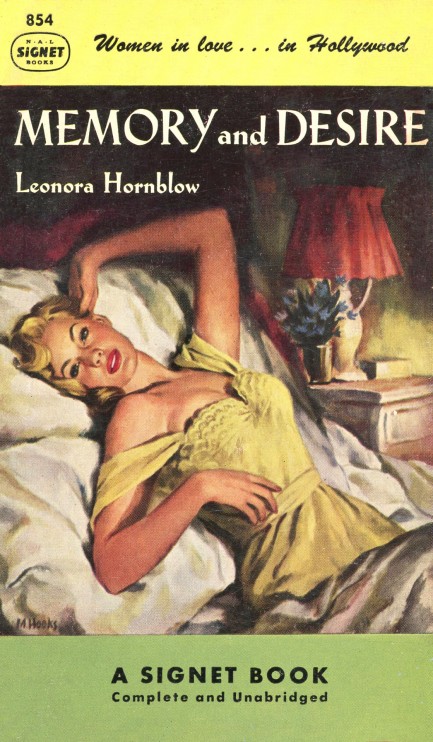
Above: a cover by Mitchell Hooks for Memory and Desire by Leonora Hornblow, whose name sounds too good to be true, but was real. She was born Leonora Salmon, but married Arthur Hornblow, Jr. in 1945 and became the proud owner of one of the great literary names of all time, though she wrote only two novels. This one deals with a Hollywood screenwriter and the affair he embarks on with a younger woman. Copyright 1958.
 Whoa. This is going to sound incredible, but right now I'm looking at what has to be the biggest bird of all time. 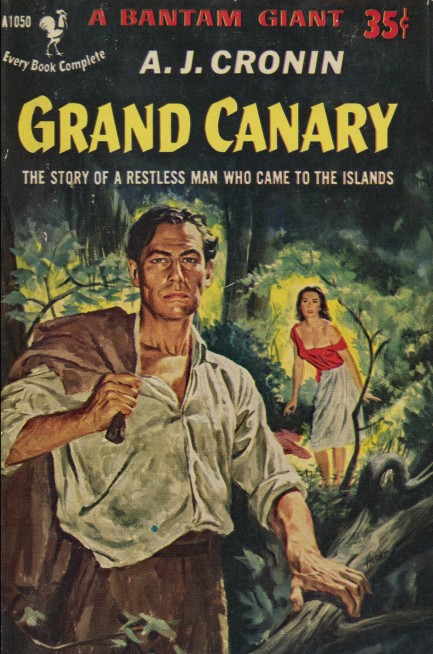
Once again we decided to read a book about someplace we've been. We just enjoy reading descriptions of places from a lifetime ago that we happen to know personally. This time it was the Canary Islands, where we spent time about five years back, depicted in A.J. Cronin's novel Grand Canary. Unfortunately, this tale concerning an assortment of characters on a steamer headed Spainward was a bit of a slog. The cast was too typical: two missionaries, a drunk, a profane older lady, a beautiful young one, a gruff captain, etc. Grand Canary was originally published in 1933, so this idea wasn't a cliché back when Cronin wrote it, but in our view it still doesn't compare well to other books about disparate characters turning up in exotic ports. The main plot involves a broken doctor trying to escape a ruined past who finds himself smack in the middle of a yellow fever outbreak. Chance for redemption? Maybe. The art on this 1952 edition from Bantam is by Mitchell Hooks, and it's excellent.
 Chase is on in his blockbuster debut. 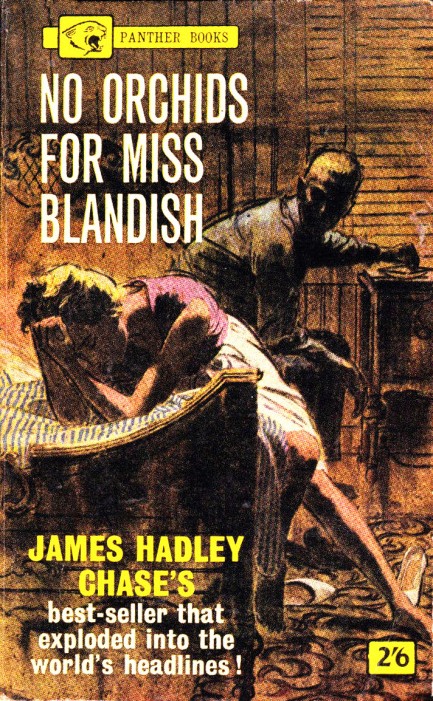
This 1961 Panther Books edition of James Hadley Chase's debut novel No Orchids for Miss Blandish labels it a bestseller that exploded into world headlines. That's quite a claim, but it's true. The book provoked a strong response when first published in 1939 due to its sexual frankness. Written in spare, hard hitting fashion, it's the multi-layered, uncompromising tale of the kidnapping of and search for the titular Miss Blandish, whose first name is never given despite her presence from beginning to end. There's violence, drugs, sexual content, and a lot of very low characters. Since we're pulp fans but not literary historians, we went into the book with no idea what it was about or that it was in any way significant, and came away immensely entertained and impressed. The highest compliment we can give it is that we were never sure who would win, or who would survive. Pair that with propulsive plotting and you end up with a must-read. World headlines? We believe it. Mitchell Hooks cover art? All the better.
 This one has both her arms—and they're .38 calibre. 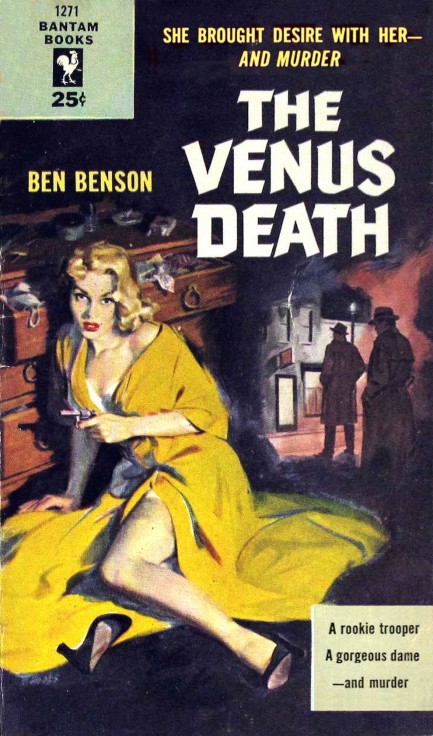
The versatile Mitchell Hooks is back, working in what we like to think of as his realistic mode on this cover for Ben Benson's The Venus Death. We wrote a little piece on Hooks and his various styles of painting. You can see that at this link. This novel is a solid thriller about the sparks that fly when a young state trooper named Ralph Lindsey crosses paths with an even younger femme fatale named Manette Venus. Yes, that's a ridiculous name, like something a stripper made up. So maybe it's no surprise that within the narrative it turns out to be a pseudonym. But Manette Venus isn't a stripper. She's just a woman with a secret—and some unsavory acquaintances.
Benson can write. He's not a master, but he also doesn't litter the narrative with grammatical clunkers or overcooked stylistic flourishes. In workmanlike fashion and in somewhat procedural detail, he tells the story of Ralph the trooper digging to the bottom of a baffling mystery involving a bizarre shooting, two guns, and the sometimes tricky place where presumption and proof clash. He learns at the end that sometimes people can be one thing, then seem to be the opposite, then turn out to be what you thought they were in the first place. That's vague, we know, but we liked the book, so you get no concrete hints. This edition came in 1954 from Bantam.
 A future literary star puts audiences on notice with a downbeat debut. 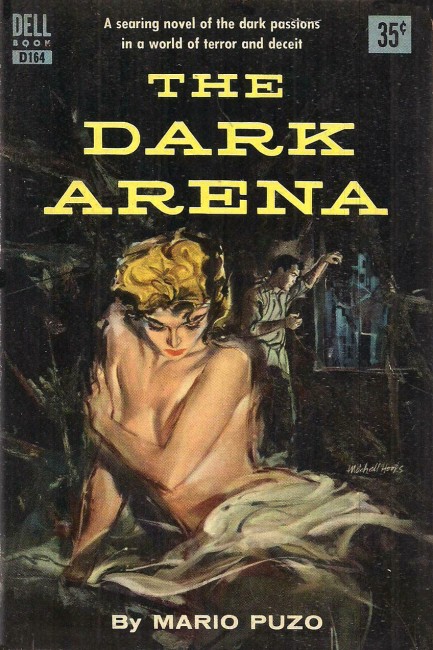
Mario Puzo published The Dark Arena in 1955. He would be world famous fifteen years later thanks to his blockbuster novel The Godfather, but here readers find him exploring post-World War II Bremen, Germany, which is bombed out and partitioned between American and Russian troops. His main character Walter Mosca tries to find purpose in this blasted landscape, but his own nature and the chaos around him prevent him finding the humanity he lost in the war. Even the love of his girlfriend Hella can't seem to fill the hole inside him. The book is overwhelmingly tragic in mood from the very first pages, and it becomes obvious which character is going to bear the brunt of the inevitable sad ending, but those aren't criticisms. Puzo's talent in this, his debut novel produced at age twenty-five, shines in the darkness. Like a lot of first books it could be pared down, but on the other hand it's interesting when Puzo stretches his literary wings in lengthy descriptive passages obviously derived from personal observation. He was clearly a star in the making. That may sound like 20/20 hindsight, but it isn't. If The Dark Arena had been the only book Puzo ever published it would be an underground classic today and people would wonder why he never built on his promise. Luckily for world literature, he did.
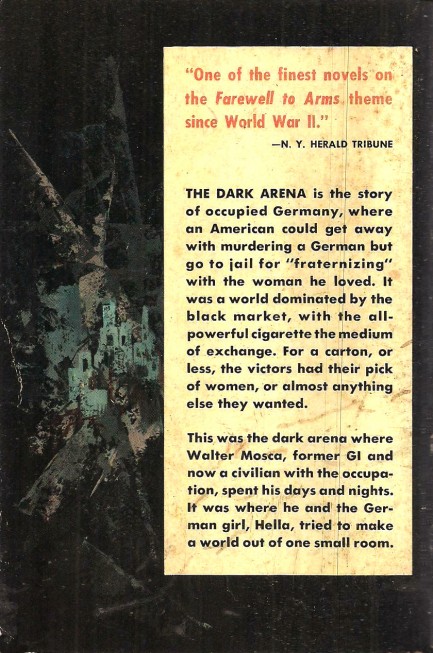
 I have to admit, you're pretty good in the sack for a capitalist running dog lackey. 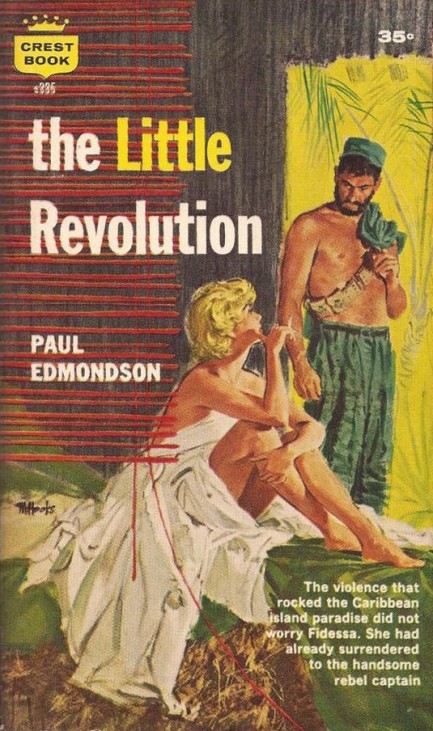
Heat, guns, passion, and politics. What more do you need for an adventure novel? Paul Edmondson's 1959 potboiler The Little Revolution is set on the fictional island of Caimanera, which is of course modeled after Cuba, where American wife Fidessa Broughton gets tangled up in a rebellion via her choice of a bedroom partner, even as her husband goes astray with a local woman, and a military captain's daughter rebels as well, in that way all teenagers do. The excellent art on this is by the eclectic Mitchell Hooks. We discussed his singular genius in detail a while back.
 Don't worry. Lava's slow. I'm fast. I'll undress, we'll screw, then we'll run for our lives. 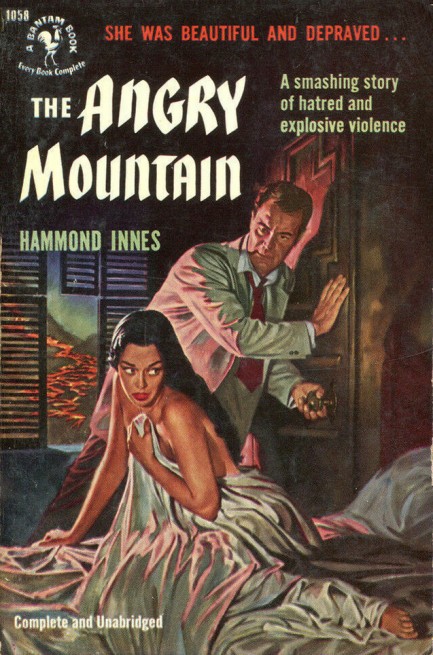
When we lived in Central America there were three volcanoes that loomed over our town. One's slope commenced just a few miles away and its peak dominated the sky to the south, but that one was extinct. The other two were not. One was dormant, but the other was active and smoked nonstop, with the prevailing wind carrying the ash away from town. This mountain occasionally shot out fountains of lava hundreds of feet high, which is a sight that will make you realize how insignificant you are the same way seeing a tornado or massive wave will. These mountains stood sentinel over many of our adventures, and were even involved in a few, including the time we visited a village on the extinct volcano and a mob of about thirty people beat a suspected thief to death.
Another time the top of that volcano started glowing red one night when we were hanging out at one of the local bars. We stood in the street with our drinks watching this spectacle, and pretty soon we could see flames around the mountain's peak. We thought we were seriously screwed. It was always understood that if that dead volcano ever came back to life there was nothing to do but kiss your ass goodbye. We decided to redouble our drinking. It turned out the flames were caused by a forest fire way up by the rim, but we gotta tell you, in those moments when we thought we might be toast, we got very efficiently hammered. It's a great memory, standing in that cobbled colonial lane, guzzling booze and waiting for the mountain to blow us all to hell.
Needless to say, for that reason the cover of 1952's The Angry Mountain by Hammond Innes sold us. The art is by Mitchell Hooks and it's close to his best work, we think. We didn't need to know anything about the book. We just wanted to see how the author used a volcano—specifically Vesuvius—in his tale, since they're a subject personal to us. The cover scene does occur in the narrative, though the couple involved aren't actually trying to have sex. Innes describes this lava lit encounter well. In fact we'd say it's described beyond the ability of even an artist as good as Hooks to capture, but that doesn't mean the book is top notch. Innes simply manages to make the most of his central gimmick.
The narrative deals with a man named Farrell who was tortured during World War II, losing his leg to a fascist doctor who amputated without anesthesia. A handful of years later Farrell is in Europe again, getting around on a prosthetic leg, when a series of events leads to him believing the doctor who tortured him is alive and living under a false identity. In trying to unravel this mystery he travels from Czechoslovakia, to Milan, to Naples, and finally to a villa at the foot of Vesuvius, along the way being pursued but having no idea why. He soon comes to understand that he's thought to be hiding or carrying something. But what? Why? And where? Where could he be carrying something valuable without his knowledge? Well, there's that hollow leg of his he let get out of his sight one night when he got blackout drunk...
That was a spoiler but since you probably don't have a volcano fetish you aren't going to seek out this novel, right? The main flaw with The Angry Mountain is that, ironically, there's not much heat. Farrell is an alcoholic and has PTSD, so he's not an easy protagonist to get behind. And his confusion about what's happening gives the first-person narrative the feel of going around in circles much of the time. And because this is a 1950s thriller, there's the mandatory love interest—or actually two—and that feels unrealistic when you're talking about a one-legged boozehound who has nightmares, cold sweats, and general stability problems. So the book, while evocative, is only partly successful. But those volcano scenes. We sure loved those.
 Goodis gets down and dirty while Hooks takes it up a notch. 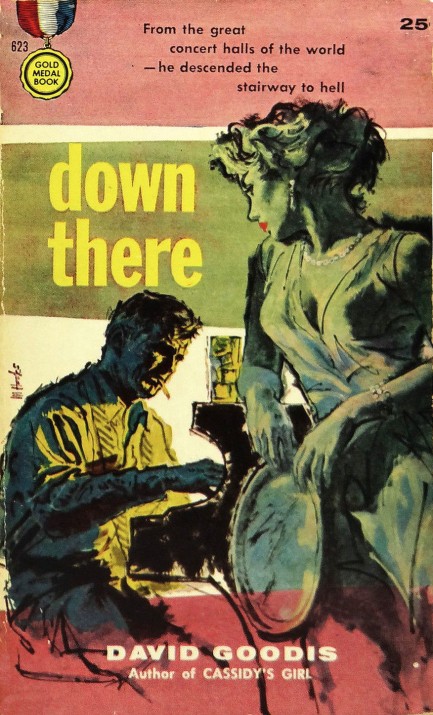
This cover for David Goodis's 1956 novel Down There was painted by Mitchell Hooks, one of the unique talents of the paperback art era. Hooks worked in different modes. Often he utilized the type of line art you'd find in a high quality comic book or graphic novel, such as here and here. Other times he used color blocking for his backgrounds, such as on the above cover and the one you see at this link. He also used a lot of color bleeds, an example of which you see on his brilliant front for Madball, the second one at this link. And he worked in a more realistic mode too, when the mood struck. For Down There he mixed techniques, using a bleed in black to impart a film noir feel, and pairing his two figures with his trademark color-blocking. The effect is magnificent. Hooks was simply a highly versatile artist who always managed to surprise, and that makes his work a constant pleasure to seek out.
His cover for Down There fits Goodis like a glove. The novel is the unrelentingly grim story of a man whose piano playing genius saves him from a life of crime and transforms him into a classical music star, but who is inexorably dragged back into the depths of violence and revenge when his criminal brother needs protection. We soon learn that there are two brothers, both crooks, both neck deep in organized crime trouble. The reader catches no breaks—Goodis is matter-of-factly dark, spinning the tale from the point-of-view of an emotionally crippled main character, and crushing hope in heartwrenching ways that make the turning of pages a real effort at times.
Why put yourself through something like this? Well, it's very stylish, so much so that French director François Truffaut fell in love with it and adapted it to film in the form of Tirez sur le pianiste, known in English as Shoot the Piano Player. Truffaut was world famous after winning best director at the 1959 Cannes Film Festival for Les Quatre Cents Coups, aka The 400 Blows, so choosing Down There for his next project says plenty about the book. Goodis was well received by French directors in general. Other adaptations of his work were made by Pierre Chenal, Jacques Tourneur, Henri Verneuil, Francis Girod, René Clément, Gilles Behat, and Jean-Jacques Beineix. That's just remarkable. We'll probably watch some of those films, and you can be sure we'll revisit both David Goodis and Mitchell Hooks imminently.

|
 |

The headlines that mattered yesteryear.
1945—Mussolini Is Arrested
Italian dictator Benito Mussolini, his mistress Clara Petacci, and fifteen supporters are arrested by Italian partisans in Dongo, Italy while attempting to escape the region in the wake of the collapse of Mussolini's fascist government. The next day, Mussolini and his mistress are both executed, along with most of the members of their group. Their bodies are then trucked to Milan where they are hung upside down on meathooks from the roof of a gas station, then spat upon and stoned until they are unrecognizable. 1933—The Gestapo Is Formed
The Geheime Staatspolizei, aka Gestapo, the official secret police force of Nazi Germany, is established. It begins under the administration of SS leader Heinrich Himmler in his position as Chief of German Police, but by 1939 is administered by the Reichssicherheitshauptamt, or Reich Main Security Office, and is a feared entity in every corner of Germany and beyond. 1937—Guernica Is Bombed
In Spain during the Spanish Civil War, the Basque town of Guernica is bombed by the German Luftwaffe, resulting in widespread destruction and casualties. The Basque government reports 1,654 people killed, while later research suggests far fewer deaths, but regardless, Guernica is viewed as an example of terror bombing and other countries learn that Nazi Germany is committed to that tactic. The bombing also becomes inspiration for Pablo Picasso, resulting in a protest painting that is not only his most famous work, but one the most important pieces of art ever produced. 1939—Batman Debuts
In Detective Comics #27, DC Comics publishes its second major superhero, Batman, who becomes one of the most popular comic book characters of all time, and then a popular camp television series starring Adam West, and lastly a multi-million dollar movie franchise starring Michael Keaton, then George Clooney, and finally Christian Bale. 1953—Crick and Watson Publish DNA Results
British scientists James D Watson and Francis Crick publish an article detailing their discovery of the existence and structure of deoxyribonucleic acid, or DNA, in Nature magazine. Their findings answer one of the oldest and most fundamental questions of biology, that of how living things reproduce themselves.
|

|
|

It's easy. We have an uploader that makes it a snap. Use it to submit your art, text, header, and subhead. Your post can be funny, serious, or anything in between, as long as it's vintage pulp. You'll get a byline and experience the fleeting pride of free authorship. We'll edit your post for typos, but the rest is up to you. Click here to give us your best shot.

|
|










